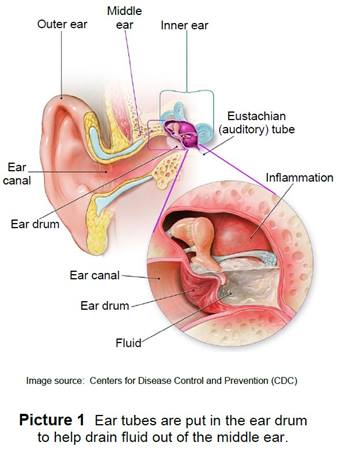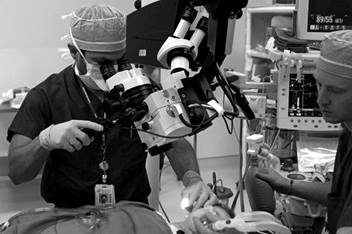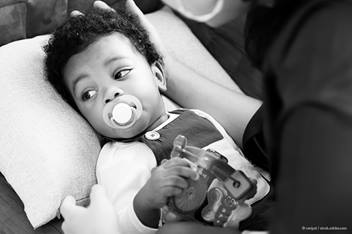Ear Infections (Otitis Media)

Otitis media is an ear infection in the middle ear. Fluid buildup behind the ear drum leads to middle ear infections (Picture 1).

When there is fluid in the middle ear, it is called an effusion. Fluid in the middle ear can cause temporary hearing loss. A person can get an ear infection at any age. However, they’re more common in children under 3 years of age. There are 2 types of otitis media: acute and chronic.
Acute Otitis Media
- Acute otitis media is caused by a bacteria or virus that causes pus to form behind the ear drum. This can lead to pain, pressure, and sometimes fever.
- It may cause permanent hearing loss if not treated. This is rare.
- This infection is usually very painful.
- Signs and symptoms:
- Fussy
- Restless or not sleeping well
- Pull or rub their ears or move their head from side to side
- Does not want to eat (loss of appetite)
- Fever over 101° Fahrenheit (F) or 38.3° Celsius (C) under the arm (axillary)
Chronic Otitis Media
- Chronic otitis media is not an infection. It is inflammation in the middle ear caused by fluid trapped behind the eardrum for more than 3 months. This can cause infections like acute otitis media to keep coming back.
- It is less painful than acute otitis media.
- This type of otitis media is not treated with antibiotics. Antibiotics treat infection but do not remove middle ear fluid.
- Signs and symptoms your child may have:
- Dizzy
- Ears feel full
- Ringing in the ears
- Ears pop when they swallow or yawn
- They turn up the volume on the TV or sit very close to it
Medicines
- You can give your child acetaminophen (Tylenol®) or ibuprofen (Motrin®) for fever, pain, and fussiness (irritability).
- Your child’s doctor or health care provider may order antibiotics for acute otitis media. Your child must take all the medicine as ordered.
Prevention
Ear infections are common. There are a few things that can help prevent them.
- Keep your child away from cigarette smoke. Do not smoke or allow smoking in your home or car.
- Always hold your baby with their head up during bottle feeding time. This keeps formula out of the Eustachian tube, which leads to the middle ear.
- Make sure your child’s vaccines (immunizations) are up-to-date.
Follow-up
- Your child will see their doctor or health care provider after they finish antibiotics.
- Some children may need a hearing test.
- If your child gets a lot of ear infections, their doctor or health care provider may refer them to an ear, nose, and throat doctor (ENT doctor or otolaryngologist). The ENT may suggest ear tube surgery.
HH-I-54 Copyright 1980, Revised 7/22, Nationwide Children’s Hospital



